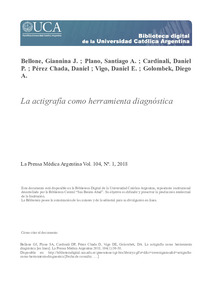Por favor, use este identificador para citar o enlazar este ítem:
https://repositorio.uca.edu.ar/handle/123456789/1453| Título: | La actigrafía como herramienta diagnóstica | Autor: | Bellone, Giannina J. Plano, Santiago Andrés Cardinali, Daniel Pedro Pérez Chada, Daniel Vigo, Daniel Eduardo Golombek, Diego A. |
Palabras clave: | MEDICINA; RITMO CIRCADIANO; SUEÑO; DIAGNOSTICO; TRASTORNOS DEL SUEÑO | Fecha de publicación: | 2018 | Editorial: | Ediciones Médicas del Sur | Cita: | Bellone G. J., et al. La actigrafía como herramienta diagnística [en línea]. La Prensa Médica Argentina. 2018, 104 (1). Disponible en: https://repositorio.uca.edu.ar/handle/123456789/1453 | Resumen: | Resumen: El diagnóstico y tratamiento de los trastornos de sueño, especialmente los asociados al Ritmo Circadiano, utilizan métodos costosos, invasivos e incómodos tanto para los pacientes como para los médicos, quienes deben realizar un seguimiento de los hábitos de sueño. La actigrafía ha sido aceptada como una herramienta válida para el estudio y diagnóstico de trastornos circadianos. Más de 300 dispositivos se comercializan actualmente para el uso personal, pero pocos de estos han sido probados para un uso diagnóstico. En este estudio comparativo compuesto por 21 sujetos, se informa acerca de los patrones de sueño y actividad registrados por algunos dispositivos, como Micro-Mini Motionlogger Watch, Condor Act Trust, MisFit Flash y Fitbit Flex. No se observan diferencias significativas en el análisis del patrón de actividad de descanso entre dispositivos. Tampoco se observan para el sueño Onset (inicio), el Tiempo Total de Sueño y la Eficiencia del Sueño. Según el tipo de estudio y análisis deseado, éstos dispositivos pueden resultar alternativos para los registros de actividad y sueño. Abstract: This is a comparative analysis of actigraphy performance in comparison with dijferent sleep Parameters. Actigraphy is a non-invasive and valid method of monitoring human rest activity cycles. Ibe report describes the role of actigraphy to assess the study ofsleep-wake patterns and circadian rhythms, evaluating its development as a diagnostic tool, with a comparative analysis of actigraphy performance in comparison with difierent sleep parameters. The diagnosis and treatment of sleep disorders, especially those associated with the cicardian rhythm, employ very expensive costs, invasives or unconfortable for the patients the same as flr physicians, who must perform a demand ofthe sleeping habits. The International Classification of Sleep Disorders has identijied more than 80 sleep disorders, all of them have associated treatments. Actinography has been accepted as a valid tool flr the study and diagnosis of circadian disorders. All these aspects are discussed in the article. |
URI: | https://repositorio.uca.edu.ar/handle/123456789/1453 | ISSN: | 0032-745X | Disciplina: | MEDICINA | Derechos: | Acceso Abierto | Fuente: | La Prensa Médica Argentina. 2018, 104 (1) ISSN 0032-745X |
| Aparece en las colecciones: | Artículos |
Ficheros en este ítem:
| Fichero | Descripción | Tamaño | Formato | |
|---|---|---|---|---|
| actigrafia-como-herramienta-diagnostica.pdf | 5 MB | Adobe PDF |  Visualizar/Abrir |
Visualizaciones de página(s)
584
comprobado en 30-abr-2024
Descarga(s)
965
comprobado en 30-abr-2024
Google ScholarTM
Ver en Google Scholar
Este ítem está sujeto a una Licencia Creative Commons

